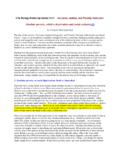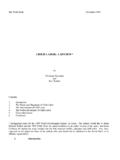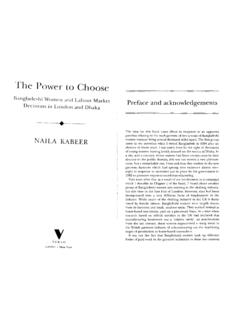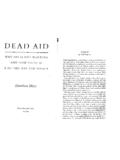Transcription of Tradable and Nontradable Goods - gdsnet.org
1 Chapter 21 Tradable and Nontradable Goods So far, we have assumed that all commodities are subject to international trade. Now, in this chapter, we introduce a simple and important reality that has profound implications for the workings of an economy. The fact is that some Goods are Nontradable . Nontradable Goods , of course, can only be consumed in the economy in which they are produced; they cannot be exported or imported. And their presence affects every impor- tant feature of an economy, from price determination, to the structure of output, to the effects of macroeconomic policy. Consider the proverbial barber shop. The barber's clientele probably comes from the neighborhood, and it certainly comes from within the domestic economy. If the demand for the barber's services drops, he cannot conveniently export the excess capacity to give haircuts.
2 If foreign barbers raise their prices for haircuts, the local barber will not experience a rush in international demand for his services. Haircuts in India are much cheaper than they are in the United States, perhaps $20 per haircut cheaper, but it does not make sense to buy a $2,000 air ticket from, say, New York to New Delhi to save $20 on a haircut. This Nontradable character of the barber's services has several di- rect implications. Without the possibility of net exports or imports, local demand and supply must balance. Without international trade, a drop in domestic demand cannot be met by an increase of net exports, and do- mestic prices can differ from foreign prices without setting in motion a shift of international demand. There are many Goods and services like haircuts that are not part of international trade. Housing rental markets are generally Nontradable as well.
3 Even if rents are cheaper in Santiago, Chile, than in Tokyo, it is hard for a Japanese household to take advantage of that fact. Thus, housing rentals differ widely, often by thousands of percent, among cities in differ- ent parts of the world. Various activities of service sectors, those of lawyers, doctors, teachers, housekeepers, and the like, also provide largely Nontradable Goods and services. Although we recognized the existence of Nontradable Goods in ear- lier chapters (especially in Chapter 10, where we pointed out that non- 6% Part V Special Topics in Macrtleconamies Suppose aht he hcrmc country product.; i~~ti C~I~S~~~CS t WCJ gotxls, tr;&t- hlcs (I I anit nnntnkdablea (N}, At this stage 01' thc dircussiorr, we shall ~e tl'l;tl the pmductim pr-ocesses ior tllc i\-r t? Goods tire on15, Itiboi~ ziud that produc~iorr in each sector' is a litmw li'utzction of the X;hs input: I ; f,% arc [he axnomta ot' labor useel iu the prociuctirrn of' tt-adkrklcsr; and ~xontruditblcs.)))]
4 Rce; at14 ansf N~C itre ha: ~tsefiicicnts I-epl-escntitlg lh6 tx~al'e:initl pl-cidkr~:.tivities of labor in Ihe prr1dttc6iun of' the tuw kin& crl' Goods . An ucl~bi~itjiiiil u11it of tobcsr in sector 'I' Iatdx lo rlr units arruro oC ou~put. Uecauur: the prodtictima fixnctiutls are lirzcar ira LI and the coefli- cicnts 111 md LJN rcpwent the avcnrgc pr'odajcriviti~.s of Inhur as well ah the r~~iqinal rartjducriuitics. 11 is usct~ul to derive the pri~iittction [' I'rontiel- IPI11;) <sf' the cCmlelXI1Y in thc 7X'F nt~.I~l. Wc it~sitlne that there ita it given utnount oI'lahor6 r I, 1 ttwt nxay tw cmpEt))~d in ~ectsf* TOI' sector Ria *I"lrcr@tilre, n\uurniitg tfrt~tr ii~%?or is htiy tmployccl, urc hme L = *t. I,\. (21 .a) Using eqiiutiuns (2 I, la, and (2 1, I b], we CRII wit c fk c~pse,*~si~m in Icrrne, of' /wtpilt kv~fs the pr~d~~t ivity ~oef%~i~t'lts, BCG~~~ISC fJ7 fx ~d i,,\ - Qyins , wc C;HI ~CWI'~~C (2 1.
5 2j a(; fdltws: Chapter 21 Tradable and Noaatradnblc Goads 663 TIIC crnrtal a\sunzpliiotl ui' the 'i'NT rm)ctcl is that kec:iusc tlxere can hc: no ~\p~rt\ or import5 c~S N. the cfomcstic crsn*\ux~ap \; tnt15t qua! domcc- tic pr~ductioi~ of' .V. fiy ~o~ltrmt. tr.;dahXe goo& Girt\ bc impcarred car ex- ptcrted, and I llus cjorrtast ie ccmsumpt iot~ vl" T cat1 differ Donr dorncdw pro- ducticrn, Spcciliailly, w luvc fhe fi~lltwitlg key t+cXatic?trsl~Eps: Nott tlu1 the h;il;tnce rill tinits of tkc tr:tdi~hlc g~rlj is cqual 10 the CXCC~~ {ti' producti~w of tradithlcs over con)riunptiun of tridiihlcc. We kntw frvnt C'hztptcr 6 timr Q, - Q'! c;m also bc wr-itlcn as Xt - [MI, where Xl i\ the level of exports of 1 itt~cf IM7 i.; tlw levcl ol impcrris of 'I. tit; cort)rirder tlrc niaturo ui' ~llttrkct ezquilil3r'lun? in thc 'I'NT mrtfcl by sul>~t'impc,sitq t ~ O( ' \~t~e~l~tie (HI the PPF, BS wc JO in Pigwe 2 1-3.]}
6 ?illppr)bl: rhal iaouschsld conhumptiolr i\ ;tt poi111 .4 on thc OC' tttttw. At ttxrt point, cnn\tltnplion otl nwtntctahlc\ i\ by 6'$: . ;mi corruunxpliuti oi' t~;dables "kfmt~iul b~tla~tcc" refers tu thc titcl that the demand lirr t~o~ltrtldt\hlcs. ecl~ials Lhc si~pply of nmltr~tdahle~ Ewtticlr is al~wtys aatisfkdk "'exte~~nril kril:tnce" refers eo ihc hcl Ihr rhe tr:rtie ~iccoun( is Law. 666 Part V Special Topics in Macroeconomics firms in the tradabIe sector have expanded production because they can sell their output abroad on the world market. Thus, the shift from trade deficit to trade surplus involves a shift in domestic production from point F to point G (which is on the same horizon- tal line as point B). Note that in the process of generating a trade surplus, the production of tradables has increased, while the production of nontradables has declined.
7 To put this another way, the trade surplus comes about not merely because of a fall in demand, but also because of a shift in supply from nontradables production to tradables production. A clear example of resources shifting from nontradables to tradables occurred in Chile after 1982. In the late 1970s, Chileans borrowed heavily, indeed too heavily, on the international capital markets. As happened in much of the developing world, international credits for Chile dried up in the early 1980s, after the period of heavy borrowing. Creditors became fearful of the ability of Chileans to sewice their debts, especially after the rise in world interest rates in the early 1980se3 Chileans had to stop running large trade deficits and start running trade surpluses, as seen in Table 21-1. Domestic demand in Chile plummeted. In effect, absorption fell from a point like D to a point like B in Figure 21-4.
8 National Unemployment Rate by Economic Activity* Building Permits Agriculture and Starts Trade and (area, thousands BalanceIGDP Year Total Fishing Construction Industry of squared meters) (%) * Figures correspond to the National Employment Survey, compiled every yeur by the National Bureau of Srutistics in the period October-December. Source: Central Bunk of Chile. The economy had to undergo a major reallocation of resources of the sort we have just described. As we see in Table 21-1, the shift from trade deficit to trade surplus was accompanied by the shift out of nontradables production, especially construction, and into tradables production, led by the agricultural sector. There was a large increase in unemployment among We discuss the origins of the international debt crisis in Chapter 22. 668 Part V Special Topics in Macroeconomics that the overriding concern behind some of these programs has been economic efficiency at the cost of eq~ity.
9 ~ Of course, these views are very different from the way the Bank evaluates its own role in supporting adjustment.$ However well designed the policy packages, it is clear that the costs of transition from trade deficits to trade surpluses among the debtor devel- oping countries during the 1980s have been extremely high. Such coun- tries have seen large increases in unemployment, and sharp declines in production and employment of nontradables have not been promptly matched by large increases in tradables production and employment. construction workers, and many of these workers shifted to work in the fruit export business or in agroindust'$. In reality, the adjustment process is far from painless, as the Chilean experience attests. As we see in Table 21-1, unemployment soared at the time that workers were laid off from construction.
10 Workers need time for retraining in order to adjust their skills to the newly available jobs. Also, as is frequently true, the economic restructuring in Chile required a geographical reallocation of labor, which took more time and occasioned significant eco- nomic and social costs. These factors, among others, explain why the unem- ployment rate increased so substantially when Chile underwent the funda- mental economic restructuring that was necessary to bring about the shift from trade deficit to trade surplus. The Dutch Disease The shift of production between tradables and nontradables tends to occur whenever there are large shifts in the level of domestic spending. This can happen when an economy starts to repay its debts, but it can occur for other reasons as well. One common case that has received considerable attention from economists is that of a country which experiences a large change in wealth because of shifts in the value of natural resources held by the resi- dents of the country.













